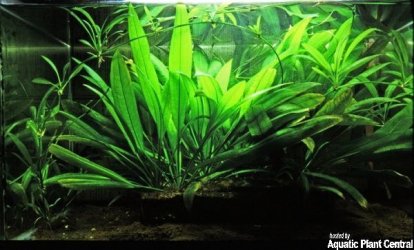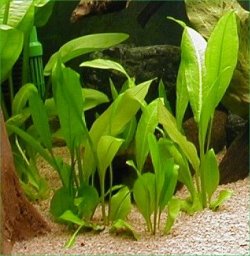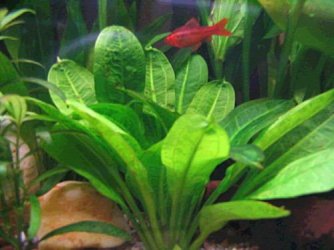I bought this plant in a bundle pack awhile back. I forgot what it is. When I went to rescape my tank today I noticed its root system spans almost the full length of the tank. Apologize for the cloudy water, I just did a water change

-
Guest, the Tank of the Year contest is underway!
💧 Which tank will win? 👉 View the entries and vote now!!
You are using an out of date browser. It may not display this or other websites correctly.
You should upgrade or use an alternative browser.
You should upgrade or use an alternative browser.
Plant identification
- Thread starter JuiceBox52
- Start date
It looks like a Rosette sword plant in my opinion
Awesome! Thanks guys
Retired Viking
Fish Connoisseur
It is a nice looking plant,  I guess I was lucking moving my sword plants the other day. They did not have a big root system and were easy to transplant.
I guess I was lucking moving my sword plants the other day. They did not have a big root system and were easy to transplant.
 I guess I was lucking moving my sword plants the other day. They did not have a big root system and were easy to transplant.
I guess I was lucking moving my sword plants the other day. They did not have a big root system and were easy to transplant.
Defiantly a sword. The swords roots at my LFS are huge. Almost the span of the 55g tank they are in.
I concur it is an Echinodorus species, and I agree with whoever suggested it was E. parviflorus, though that name is a bit misleading.
The "natural" E. parviflorus is now determined not to be a distinct species but a variant of E. grisebachii according to phylogenetic analysis (the plant's DNA). The plant in the photo is further the artificial variety developed some years ago by the Tropica Nursery, and can properly be called "Echinodorus parviflorus 'Tropica'," as this is not a natural species so the Nursery was free to name it whatever they liked.
This is quite a lovely plant; the darker green rounded leaves with their crinkly appearance is a nice contrast to most other plants.
The "natural" E. parviflorus is now determined not to be a distinct species but a variant of E. grisebachii according to phylogenetic analysis (the plant's DNA). The plant in the photo is further the artificial variety developed some years ago by the Tropica Nursery, and can properly be called "Echinodorus parviflorus 'Tropica'," as this is not a natural species so the Nursery was free to name it whatever they liked.
This is quite a lovely plant; the darker green rounded leaves with their crinkly appearance is a nice contrast to most other plants.
Further to my previous post, here are some photos and a bit more explanation for those interested.
The first three photos are of the so-called wild natural plant, Echinodorus parviflorus Rataj 1970. The natural “species” from which this plant was derived was described by Karl Rataj (1970) as Echinodorus parviflorus; the species epithet means small-flowered.
The two subsequent photos are of the cultivar 'Tropica' which was cultivated in Singapore and Sri Lanka and in the early 1980's the Danish aquatic plant nursery Tropica received a shipment; the Danish botanists Jacobsen & Holm-Nielsen described the cultivar in 1985 and named it in honour of the Tropica nurseries. You will note that this plant is quite different from the "wild" original.
Haynes & Holm-Nielsen (1994) considered the species E. bleherae Rataj, 1970, E. amazonicus Rataj, 1970 and E. parviflorus Rataj, 1970 to be conspecific [= the same species] with E. grisebachii Small, 1909. Kasselmann (2002) suggested that the different habitus of the submersed plants between these three "species" is reason to retain the present names in the hobby. But Samuli Lehtonen's extensive phylogenetic analysis (2008) basically supports the findings of Haynes & Holm-Nielsen, with a few changes, and this classification is now accepted. E. parviflorus is not a distinct species but is in fact within the one polymorphic species E. grisebachii complex. Differences in appearance between these plants are apparent and seem dependant on the specific environment in the aquarium; this seems likely to also occur in nature, what can be termed transitional forms of the species. But the limited genetic variation within the complex is insufficient to establish reasonable groupings (Lehtonen & Falck, 2011). This species epithet grisebachii takes precedence over the others under the rules of the International Code of Botanical Nomenclature because it was the first name assigned to the species, and this was by the American botanist J.K. Small in 1909; the name honours the German botanist H.R.A. Grisebach (1814-1879).
Confusion has existed for the past few decades over the number of species in the genus Echinodorus, and many have been known under different names. In his earlier study of the genus, Karl Rataj (1975) listed 47 species. A major revision by the botanists R.R. Haynes and L.B. Holm-Nielsen (1994) listed 26 species. In his 2004 revision, Rataj increased the number of species to 62. More recent work by the Finnish botanist Samuli Lehtonen—incorporating phylogenetic (DNA) analysis—proposed 28 valid species (Lehtonen, 2007). As of 2013, The Plant List and the World Checklist of Selected Plant Families (maintained by Kew) have 30 distinct species listed for Echinodorus.
The first three photos are of the so-called wild natural plant, Echinodorus parviflorus Rataj 1970. The natural “species” from which this plant was derived was described by Karl Rataj (1970) as Echinodorus parviflorus; the species epithet means small-flowered.
The two subsequent photos are of the cultivar 'Tropica' which was cultivated in Singapore and Sri Lanka and in the early 1980's the Danish aquatic plant nursery Tropica received a shipment; the Danish botanists Jacobsen & Holm-Nielsen described the cultivar in 1985 and named it in honour of the Tropica nurseries. You will note that this plant is quite different from the "wild" original.
Haynes & Holm-Nielsen (1994) considered the species E. bleherae Rataj, 1970, E. amazonicus Rataj, 1970 and E. parviflorus Rataj, 1970 to be conspecific [= the same species] with E. grisebachii Small, 1909. Kasselmann (2002) suggested that the different habitus of the submersed plants between these three "species" is reason to retain the present names in the hobby. But Samuli Lehtonen's extensive phylogenetic analysis (2008) basically supports the findings of Haynes & Holm-Nielsen, with a few changes, and this classification is now accepted. E. parviflorus is not a distinct species but is in fact within the one polymorphic species E. grisebachii complex. Differences in appearance between these plants are apparent and seem dependant on the specific environment in the aquarium; this seems likely to also occur in nature, what can be termed transitional forms of the species. But the limited genetic variation within the complex is insufficient to establish reasonable groupings (Lehtonen & Falck, 2011). This species epithet grisebachii takes precedence over the others under the rules of the International Code of Botanical Nomenclature because it was the first name assigned to the species, and this was by the American botanist J.K. Small in 1909; the name honours the German botanist H.R.A. Grisebach (1814-1879).
Confusion has existed for the past few decades over the number of species in the genus Echinodorus, and many have been known under different names. In his earlier study of the genus, Karl Rataj (1975) listed 47 species. A major revision by the botanists R.R. Haynes and L.B. Holm-Nielsen (1994) listed 26 species. In his 2004 revision, Rataj increased the number of species to 62. More recent work by the Finnish botanist Samuli Lehtonen—incorporating phylogenetic (DNA) analysis—proposed 28 valid species (Lehtonen, 2007). As of 2013, The Plant List and the World Checklist of Selected Plant Families (maintained by Kew) have 30 distinct species listed for Echinodorus.
Attachments
This is wonderful! I'm very new to aquarium plants, and have had some difficulty identifying some of them. Would you be able to point me to resources that are good for helping laypeople identify a plant please? Or where you get information like this? It's really interesting stuffFurther to my previous post, here are some photos and a bit more explanation for those interested.
The first three photos are of the so-called wild natural plant, Echinodorus parviflorus Rataj 1970. The natural “species” from which this plant was derived was described by Karl Rataj (1970) as Echinodorus parviflorus; the species epithet means small-flowered.
The two subsequent photos are of the cultivar 'Tropica' which was cultivated in Singapore and Sri Lanka and in the early 1980's the Danish aquatic plant nursery Tropica received a shipment; the Danish botanists Jacobsen & Holm-Nielsen described the cultivar in 1985 and named it in honour of the Tropica nurseries. You will note that this plant is quite different from the "wild" original.
Haynes & Holm-Nielsen (1994) considered the species E. bleherae Rataj, 1970, E. amazonicus Rataj, 1970 and E. parviflorus Rataj, 1970 to be conspecific [= the same species] with E. grisebachii Small, 1909. Kasselmann (2002) suggested that the different habitus of the submersed plants between these three "species" is reason to retain the present names in the hobby. But Samuli Lehtonen's extensive phylogenetic analysis (2008) basically supports the findings of Haynes & Holm-Nielsen, with a few changes, and this classification is now accepted. E. parviflorus is not a distinct species but is in fact within the one polymorphic species E. grisebachii complex. Differences in appearance between these plants are apparent and seem dependant on the specific environment in the aquarium; this seems likely to also occur in nature, what can be termed transitional forms of the species. But the limited genetic variation within the complex is insufficient to establish reasonable groupings (Lehtonen & Falck, 2011). This species epithet grisebachii takes precedence over the others under the rules of the International Code of Botanical Nomenclature because it was the first name assigned to the species, and this was by the American botanist J.K. Small in 1909; the name honours the German botanist H.R.A. Grisebach (1814-1879).
Confusion has existed for the past few decades over the number of species in the genus Echinodorus, and many have been known under different names. In his earlier study of the genus, Karl Rataj (1975) listed 47 species. A major revision by the botanists R.R. Haynes and L.B. Holm-Nielsen (1994) listed 26 species. In his 2004 revision, Rataj increased the number of species to 62. More recent work by the Finnish botanist Samuli Lehtonen—incorporating phylogenetic (DNA) analysis—proposed 28 valid species (Lehtonen, 2007). As of 2013, The Plant List and the World Checklist of Selected Plant Families (maintained by Kew) have 30 distinct species listed for Echinodorus.
This is wonderful! I'm very new to aquarium plants, and have had some difficulty identifying some of them. Would you be able to point me to resources that are good for helping laypeople identify a plant please? Or where you get information like this? It's really interesting stuffI do wish I could go back and tell 12 year old me to sign up for those latin classes in school. I didn't see the point in learning a dead language at the time, but subsequent interests in plants and animals taught me how useful it would have been to learn!
Thank you. Identification of aquatic (aquarium) plant species is not usually easy. The one example of the variety in appearance, leaf shape, even leaf colour, of the four "species" that are now known to actually be just one species with varieties illustrates this difficulty. If one looks at two plants with differing leaf shapes one would not usually assume they are in fact one distinct species. With other plants, like the Cryptocoryne species, it is the flower that is used to determine the species, but these plants rarely flower in an aquarium. Vallisneria species have a similar problem, but one made even more involved by the fact that there are quite different male and female flowers within the individual species, and rarely will we see them together.
I acquired what I thought were Amazon Frogbit plants some years ago, and they flowered shortly after I acquired them. I posted photos on another forum, and the forum owner sent me an email he had received from someone in the US Department of Agriculture informing him that the plant was an invasive species illegal in many states, and we should not be promoting it. Turns out there are three "Frogbit" species, one tropical but two temperate, and it was one of the latter that I had been sold to me and the flowers identified the species. Leaves are identical on both, so without the flowers or DNA analysis one might never know which we have.
Another issue we now have to contend with are the many hybrids the hobby has generated over the last couple of decades. All of the variegated leaf plants in the Echinodorus (sword) plant group are artificial hybrid plants that do not occur in nature.
I have researched the literature and scientific studies on some aquarium plants over the past 15 or so years, and written profiles for another forum. I am not a trained botanist, far from it, but I do have a strong interest in research and science and these days with the internet resources we can with some effort find a lot of good information. One excellent book is Peter Hiscock's Encyclopedia of Aquarium Plants. Another more detailed and scientific is Christel Kasselmann's Aquarium Plants (English edition as well as the original German). These are rather good as identification tools, and Dr. Kasselmann's does include a lot of scientific and taxonomy data. But some of this is being changed as we discuss, with the advancements now possible through phylogenetic analysis.
Similar threads
- Replies
- 0
- Views
- 379
- Replies
- 3
- Views
- 377
- Replies
- 7
- Views
- 367







